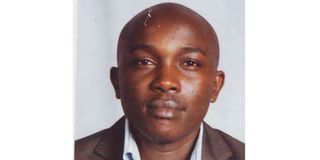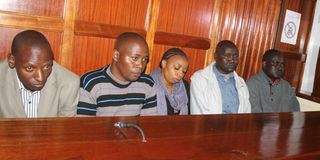Premium
Willie Kimani murder: A timeline

Human Rights lawyer Mr Willie Kimani whose body and that of his client Josephat Mwenda, and driver Joseph Muiruri were found in Ol-Donyo Sabuk, Athi River.
In 2016, three men – lawyer Willie Kimani, his client Josephat Mwenda and their taxi driver Joseph Muiruri – disappeared after they were last seen at a police station in Syokimau. That morning, Kimani and Mwenda had attended a court session in Mavoko for a case Mwenda had filed a against a police officer. Two weeks later, the bodies of the three men were found nearly 100km away in a river in Ol Donyo Sabuk.
Four Administration Police officers and a police informant, Peter Kamau, were charged with their murder. The officers -- Sylvia Wanjohi, Fredrick Lelliman, Stephen Cheburet and Leonard Mwangi -- and Mr Kamau will know their fate today.
Here is a timeline of the events leading up to and following the murders:
2015
April 10: Josephat Mwenda is stopped by police officer Fredrick Lelliman, who accidentally shoots him in the hand. Three days later, Mwenda is charged with three counts: drug possession, gambling and resisting arrest.
Mwenda files a complaint against the officer at the Independent Policing Oversight Authority (IPOA) and lawyer Willie Kimani begins investigating the case on behalf of International Justice Mission (IJM), an international NGO that helps vulnerable people get justice.

Mr Josephat Mwenda, a boda boda rider who had accused a police officer of shooting him in the hand during an arrest bid.
December 14: Lelliman and other police officers abduct Mwenda from his home at night. The next day, Mwenda is charged with six additional counts of traffic violations. Lelliman claims Mwenda was violating the law while riding a motorcycle despite the fact that his gunshot injury to his hand prevented him from doing so.
2016
February 14: IJM officially takes on Mwenda's case. Lawyer Willie Kimani is assigned to represent him.
Later the same month, Mwenda, his co-accused and lawyer Kimani are detained after a court hearing by police officers who say they want to question the men about a robbery with violence case that had happened in Meru. They are held for several hours and then released with no further explanation.
February 24: IJM writes to the office of the Inspector General of Police, IPOA and the Witness Protection Agency (WPA) to complain of Lelliman’s misconduct and to request protection for Mwenda.
March 1: WPA decision on witness protection for Mwenda remains pending because he is an accused in the ongoing court case and not a victim, thus the law does not guarantee him protection.
March 16: IPOA summons Lelliman to submit a statement about the claims of misconduct.

Police officer Fredrick Leliman in a Nairobi Court on July 18, 2016 over the murder of lawyer Willie Kimani, his client Josephat Mwenda and taxi driver Joseph Muiruri.
June 23: Lawyer Kimani, Mwenda and their taxi driver Joseph Muiruri are abducted after leaving court following a hearing on the traffic violation charges. The three are held in a police container at the station without being booked. Kimani manages to scribble a note on a piece of tissue. In it, he notes down the number of his client's wife and asks whoever sees it to tell her to get help.
“Tafadhali pigia 079*** (Rebeka) mwambie aambie Rose Willie na Mwenda wameshikwa na wako Syokimau kwa Chief wako hatarini,” the note says. The note is thrown out of the container's window. It is later found by a motorcycle rider.
The rider attempts to call Mwenda's wife, but she did not pick it as she did not recognise the number. He throws away the tissue. By that evening, the IJM team mounts a search to find them, going to police stations and calling out their names, but they had been removed from the station at 7:30pm, prior to the time IJM staff arrived.
It's estimated that the three men were killed at about 10:00pm.
June 24-29: A missing persons report is filed. IJM staff and police continue to search in police stations and morgues. The men's mobile phones are found scattered. Details of the story enter the public sphere creating uproar. Lawyers in Kenya go on strike. IJM and Police Reforms Working Group (PRWG) publish a press release June 29.
June 30-July 1: The bodies of Willie, Joseph and Josephat are discovered in a river in Ol Donyo Sabuk, Machakos County.
June 30: The Law Society of Kenya (LSK) files a habeas corpus application requiring persons in police custody to be produced in court. The application seeks to have the three missing men produced alive or dead (at this point, the discovery of their bodies had not been announced).
Later, the bodies are positively identified and IJM holds a press conference to announce the deaths. A post-mortem later found that a boulder may have been used to crush Kimani's skull.
July 1-5: Four police officers are detained in connection with the killings.
July 4-8: Lawyers strike and hold marches to protest extrajudicial killings. IJM staff join LSK in the marches.
July 8: Memorial service for Willie, Joseph and Josephat. Gary Haugen, the CEO of IJM, speaks.
July 9: Willie Kimani is buried.
July 11: Josephat Mwenda is buried.

Caskets carrying the remains of slain lawyer Willie Kimani (left), his client Josephat Mwenda (right) and their driver Joseph Muiruri (centre) lie at Consolata Shrine during their requiem mass that was held in Nairobi on July 8, 2016.

Relatives of slain lawyer Willie Kimani, his client Josephat Mwenda and their driver Joseph Muiruri comfort each other at Consolata Shrine following their requiem mass in Nairobi on July 8, 2016.
July 18: Four police suspects are formally charged.
August 11: Judgement for habeas corpus filing finds that the police failed to act on Mwenda's IPOA complaint, says the men might have been alive if they did.
August 23: A 5th suspect, a civilian police informer, is charged.

From Left: Peter Ngugi Kamau, Leonard Mwangi Maina, Sylvia Wanjiku Wanjohi, Stephen Cheburet Morogo and Fredrick ole Lelliman at the High Court in 2016.
November 10: Trial of police officers Fredrick Ole Leliman, Stephen Cheburet, Sylvia Wanjiku, Leonard Mwangi and informer Peter Ngugi starts.

Peter Ngugi, a police informer and one of the accused persons in the murders of lawyer Willie Kimani, Josphat Mwenda and taxi driver Joseph Muiruri.
2017
May: Machozi Ya Jana, a song, by Juliani, is released to bring attention to police abuse of power.
June: First anniversary commemoration. Community dialogues are held to allow neighborhoods with high levels of police abuse of power to share their experiences – 68 cases of what appears to be Extrajudicial killings (EJKs) or Enforced Disappearances (EDs) were identified, 22 of these case later formed the basis of a class action suit. The dialogues were attended by police representatives.
July: IJM and partners in the civil society including the Police Reform Working Group (PRWG-K) launch online petition for the removal of Deputy Police IG Samuel Arachi from office. They submit a petition with demands to the President of Kenya to “secure justice for three, and safety for all.” At this point, 40,000 people have signed the petition.
2018
January: Deputy IG Arachi is removed.
August: Missing Voices is established by civil society groups to compile and share data on police killings and disappearances.
September: President Uhuru Kenyatta announces far-reaching police reforms, including the streamlining of the police command structure to allow greater oversight and accountability. Members of the PRWG-K, including IJM, are invited to give their views on the reforms.
November: A class-action suit is filed by IJM and 22 victims of extrajudicial killings and disappearances.
2020
February: ODPP collaborates with IPOA to commence development of Standard Operating Procedures(SOPs) to streamline and enhance efficiency in investigating and prosecuting cases of human rights violations by police.
June 8: Decision to Charge guidelines are released. The guidelines will protect victims like Mwenda against charges brought by police that have no evidence.
October: In response to the class-action suit, the court orders the Inspector General to investigate 22 cases of police killings that took place between 2014 and 2017.
2021
September: Mavoko 3 Prosecution case is closed. The prosecution tabled CCTV footage and car tracking devices, showing how Kimani was picked by the taxi driver on that day somewhere in Westlands and headed to Mavoko Law Courts where he was scheduled to represent Mwenda. The judge rules that the police officers and civilian informer have a case to answer.
December: The Defence closes its case.
2022
February 10-11: Final submissions are presented to Justice Jessie Lessit and she announces she will make a decision within 60 days.
In total, 117 exhibits, 46 prosecution witnesses and 34 defence witnesses were presented in court during hearings of the case.
July 22: In her judgment, Justice Lessit finds three AP police officers -- Sergeant Fredrick Ole Leliman, Stephen Cheburet, Sylvia Wanjiku, and informer Peter Ngugi guilty of the murders of lawyer Kimani, his client Mwenda and taxi driver Muiruri. The fourth accused person, Sergeant Leonard Mwangi, is acquitted of all charges. She directed that the case be mentioned on September 3, 2022 to confirm filing of probation and victim assessment reports and for further directions on sentencing and mitigation.
Watch Justice Lessit's judgment in full below:





